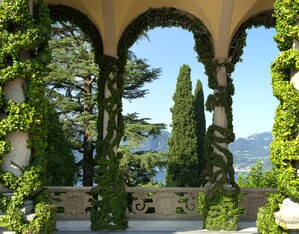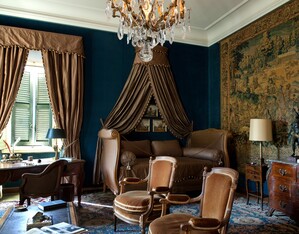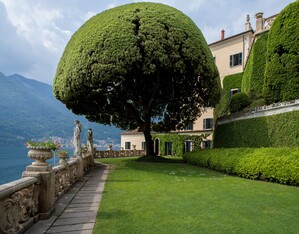The impeccable velvets of the meadows, the sinuous paths that descend to the lake, the vegetation shaped by an ancient and skilful hand, with well-tamed plane trees and wisteria and tangles of Ficus pumila: an eclectic garden that has fascinated writers and artists.
Built by Cardinal Angelo Maria Durini between 1787 and 1796, the Villa del Balbianello stands at the end of the Dosso di Lavedo, in a highly suggestive position. The manor house incorporates an ancient convent dedicated to San Giovanni and an oratory of which the two bell towers survive. Other buildings, such as the House of the Guardian, thereIcebox, there Bosco House and the Greenhouse dot its park. Upstream, the Loggia it offers a double view of the banks of the Tremezzina and the Comacina island. Downstream, a small inlet hosts a marina, where the motto “Fay ce que voudras” (do what you want) stands out. From the lake, the steep staircase leading to the villa leads to a panoramic terrace bordered by a stone balustrade. The design of the gardens is based on the natural imprint of the places, adapting to the impervious spaces of the peninsula. Laurel and box hedges impose geometric matrices on lawns set in narrow terraces. Bushes of azaleas and rhododendrons, wisteria and a rich sculptural heritage are distributed along sinuous paths, shaded by large “candelabra” plane trees, holm oaks, camphor, magnolias and cypresses. After Cardinal Durini’s death, the villa changed owners several times. Giuseppe Sepolina, Luigi Porro Lambertenghi and then the Marquis Giuseppe Arconati Visconti received numerous politicians and men of culture. Over time, the villa has welcomed the scholars Giuseppe Parini, Silvio Pellico, Giovanni Berchet and Alessandro Manzoni, but also the French Prime Minister Léon Gambetta and the painter Arnold Böcklin. In 1974 the house was purchased by the count and explorer Guido Monzino, who in 1988 left it to the Fondo per l’Ambiente Italiano.
Highlights

The Loggia
Authentic invention of Balbianello, the Loggia opens onto the landscape through six large arches. Two symmetrical rooms host the Music Room (today “of the cartographer”) and the Library, with over four thousand volumes from the Monzino collection, dedicated to mountaineering and polar expeditions.

The art collections
Among Baroque furnishings, Flemish tapestries and oriental artifacts, the villa houses an important collection of glass paintings and views of Lake Como. Upstairs the relics of Guido Monzino's businesses are exhibited. Among these is one of the eight sleds with which he reached the North Pole in 1971.

Two villas for a cardinal
The villa owes its name to the small size that distinguishes it from Cardinal Durini's first summer residence: the Villa del Balbiano. With its elliptical entrance, formal gardens and the Nymphaeum, this luxurious residence lies on the banks of Ossuccio, less than two kilometers from the Balbianello.
 Villa del Balbianello – FAI
Contacts
Villa del Balbianello – FAI
Contacts
Contacts
Telephone:+39 0344 56110
Address
Via Guido Monzino, 1
22016, Tremezzina (CO)

FAI Fondo Ambiente Italiano
 Villa del Balbianello – FAI
Opening times and prices
Villa del Balbianello – FAI
Opening times and prices
Opening hours
The villa is open all year round on Tuesdays and from Thursday to Sunday, from 10.00 to 18.00.
Pricing
Entrance to the Loggia, the museums and the garden with free visit
- Full € 15.00
- Children (6-18 years) € 8.00
- National Trust members and students up to 25 years € 10.00
- Family: 2 adults and 2 or more children (6 – 18 years) € 40.00
- Free admission for FAI Members, Children up to 5 years, Residents of the Municipality of Tremezzina, Bienfaiteurs Amis du Louvree Members and disabled people with a companion
Bosco entrance
- Full € 3.00
- Children (6-18 years) € 1.00
- National Trust members and students up to 25 years € 1.00
- Family: 2 adults and 2 or more children (6 – 18 years) € 7.00
- Free admission for FAI members, children up to 5 years, residents of the Municipality of Tremezzina, Bienfaiteurs Amis du Louvre members and disabled people with a companion
 Villa del Balbianello – FAI
How to get there
Villa del Balbianello – FAI
How to get there
Address
Via Guido Monzino, 1
22016, Tremezzina (CO)
Latitude: 45.9652637
Longitude: 9.2002927
How to arrive by road
From Como: SS340 for Menaggio
From Milan: A9 Milano-Laghi motorway, exit at Lake Como, and continue on the SS340 towards Menaggio
From Switzerland (Lugano): Lugano-Menaggio road, continue on SS340 towards Como. Continue until Lenno. Reach the Mercato Parking, in via degli Artigiani, then continue on foot or by paying taxiboat from Lido di Lenno.
How to arrive by train
With Trenord trains, Milan branch: get off at Como Lago station.
10% discount on the entrance ticket for holders of an ordinary Trenord ticket validated on the same day of the visit to the location of the FAI Property served by Trenord rail transport. Specifically: Como.
How to arrive by bus
From Como to Lenno, bus line SPT C10. Lenno stop, then continue on foot or by taxiboat.
Follow the directions from the church square and from Lido di Lenno
How to arrive on foot
It is possible to reach the Villa on foot from Lenno. It is 1 km away with an uphill stretch, which can be covered in about 25 minutes.
 Villa del Balbianello – FAI
Services/Accessibility
Villa del Balbianello – FAI
Services/Accessibility
Services
Dogs are allowed in the gardens on a leash, inside the Villa only guide dogs or small dogs to be held in the arms or a special carrier for the duration of the visit.
There is no parking reserved for visitors, but it is possible to park in the public car park of Lenno in Via degli Artigiani.
Coffee bar
At Villa del Balbianello it is possible to book a table in the cafeteria on Saturdays and Sundays. For more information and reservations call the following number: +39 33388899
In addition to the garden, it is possible to visit the interior of the villa. The mansion elegantly overlooks a wide panorama that makes it one of the most scenic residences of the Lario. The initiator of the Balbianello wonders was Cardinal Durini, a man of letters and patron of the arts, who at the end of the eighteenth century chose this corner of the lake to make it a retreat of delight and literary entertainment. A vocation recovered in modern times by Guido Monzino, entrepreneur, collector and passionate traveler, who in 1974 made the Villa a refuge where to preserve with order and taste the memories of an adventurous life that led him, the first Italian, to the summit of Everest. His daily life and fortunate deeds emerge from maps, travel tools, books, furnishings and precious as well as curious collections of ancient and primitive art objects: everything is still set up according to his will, like the relics of his well-known mountaineering enterprises. , kept in the fascinating Museum of Expeditions.
Accessibility
 Villa del Balbianello – FAI
Private events
Villa del Balbianello – FAI
Private events
 Villa del Balbianello – FAI
Itineraries
Villa del Balbianello – FAI
Itineraries
You could find the garden in these itineraries
 Favorite saving result
Favorite saving result
 Warning!
Warning!
You've have to sign up or sign in to add this element to your favorites.
